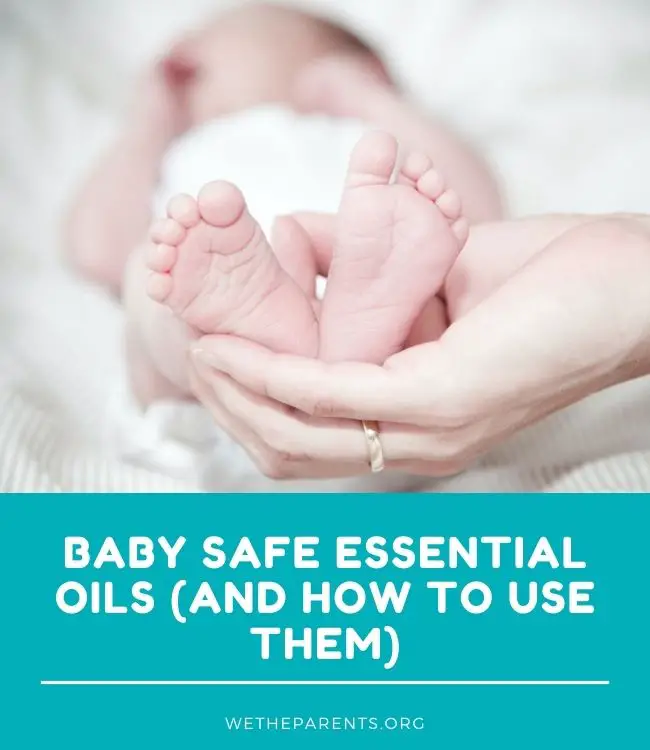Though essential oils have come back into popular use as a naturopathic remedy, they’re not just a trend. The plant-sourced concentrates have had a place in medicine for several thousand years, and their potency and efficacy has been proven.
When baby safe essential oils are chosen and used properly, your little one can reap some of their benefits. However, some essential oils aren’t safe for babies, and inappropriate use of essential oils can be harmful to children and adults alike.
Let’s dive in.
In this article:
What are essential oils?
Essential oils are extremely concentrated oils which are extracted from plants. The oil that results from the extraction process is considered to be the essence of the plant, resulting in the name ‘essential oil’.
These oils may also be called volatile or ethereal oils, or may be referred to as (plant) oil or oil of (plant) — rose oil, for example.
It’s important to know that not all products marked essential oil are reputable or high quality. Some products claim to be 100% pure, but have additives including alcohol, artificial fragrance, or carrier oil.
In order to avoid buying essential oils that are low-quality or potentially fake, stick to trusted brands, some of which include:
- Plant Therapy
- NOW Foods
- Eden’s Garden
- Young Living
- Rocky Mountain Oils
- doTERRA
If you choose to shop outside these brands, watch for the following indicators that an essential oil is fake or has been diluted:
- A plastic bottle: Essential oils are potent, and can cause plastic to break down; thus, true essential oils will not be stored in plastic bottles.
- A clear bottle: Essential oils are vulnerable to spoiling with exposure to UV radiation, so your bottle should be a dark color — cobalt blue and deep amber are popular choices.
- No Latin name: Reputable producers of essential oils list both the common and Latin botanical names on a product’s labeling.
- No safety instructions: Because improper use of essential oils can be hazardous, all reputable companies include instructions for using the oils safely. If you don’t see safety instructions, the product shouldn’t be trusted.
Because these oils are very potent, they shouldn’t be directly applied to the skin. Instead, a carrier oil like grapeseed, almond, or coconut should be used (see Essential Oils and Baby for proper dilution ratios).
Another way to use essential oils is via a diffuser, which dilutes the oil in water and emits a fine mist which scents the room. Some parents find this to be a preferable alternative to skin application, especially in sensitive-skinned children.
Essential oils and baby
While your baby can benefit from the proper use of several essential oils, it’s important that you choose the right oils and use them properly. Babies under 12 weeks should not be exposed to essential oils, whether topically or diffused.
Essential oils must be diluted before use by people of any age, but the dilution ratio increases when applying oils to your baby.
When making a topical oil or cream for a baby using essential oils, the product must not contain more than ..25 to .5% oil. By comparison, a product for adults may contain between 2.5% to 10% essential oil.
It’s okay to increase this ratio to 1-2% for children between 2 and 6, and to go as high as 3% for children between 6 and 15. The recommended safety ratio for anyone over 15 is between 2.5% and 5%.1Are Essential Oils Safe for Children?
hopkinsallchildrens.org
Diluting essential oils does make them less potent and likely to irritate, but it’s not foolproof — they may still cause irritation and sun sensitivity in some children.
In order to avoid a large-scale reaction, performing a patch test in a small area is recommended. This simply means applying a dime-sized amount of product to your baby’s leg or arm, and waiting a full 24 hours to observe for any reaction (this can include inflammation, redness, or pain).
If your baby passes the patch test without irritation, you’re likely in the clear to continue using the product. If any reaction does occur, immediately discontinue use.
Spritzing diluted essential oils or diffusing them with a water vaporizer are two options parents may prefer, as they eschew the risk of skin reactions. However, your baby may still experience irritation in reaction to the essential oil vapor, so start by diffusing small amounts of oil for no more than 60 minutes to observe the results.
Never allow a baby or child to consume essential oils. Only food-grade essential oil is safe for consumption, and it shouldn’t be given to children.
Do not add essential oil to bathwater, even though it is highly diluted. This increases the risk of accidental consumption.
If your baby or child develops the following symptoms, discontinue oil use and consult your pediatrician:
- Significant rashes or skin irritations
- Headache
- Breathing difficulties, including coughing or wheezing
- Nausea, vomiting
- Other inexplicable discomfort
7 essential oils safe for baby (and what they do)
1. Eucalyptus
Latin name: Eucalyptus Radiata
Benefits: Expectorant, treats respiratory congestion
Best Use: Diffuser (see safety tips)
Safety Tips: Choosing the right kind of eucalyptus oil for your baby is essential — Eucalyptus radiata is child-safe, while Eucalyptus globulus is not. As accidental ingestion is associated with respiratory depression and vomiting, it’s wise to consult your pediatrician before beginning to use eucalyptus essential oil for baby’s cold.2Flaman, Z., Pellechia-Clarke, S., Bailey, B., & McGuigan, M. (2001). Unintentional exposure of young children to camphor and eucalyptus oils. Paediatrics & child health, 6(2), 80-83.
ncbi.nlm.nih.gov
2. Tea Tree
Latin name: Melaleuca alternifolia
Benefits: Antifungal, antimicrobial, useful for treating fungal infections and some types of diaper rash
Best Use: Diluted topical application (see safety tips)
Safety Tips: Compared to some other essential oils, tea tree oil can be harsh — the same natural drying properties that make it ideal for rashes can cause irritation on very sensitive skin, or if the oil isn’t diluted enough.3 Veal, L. (1996). The potential effectiveness of essential oils as a treatment for headlice, Pediculus humanus capitis. Complementary Therapies in Nursing and Midwifery, 2(4), 97-101.
hopkinsallchildrens.org/ACH-News/General-News/Are-Essential-Oils-Safe-for-Children…
3. Chamomile
Latin name: Chamamelum nobile, Matricaria chamomilla
Benefits: Treats insomnia, encourages relaxation and sleep, may improve fussiness, may improve colic symptoms when paired with lavender 4Miraj, S., & Alesaeidi, S. (2016). A systematic review study of therapeutic effects of Matricaria recuitta chamomile (chamomile). Electronic physician, 8(9), 3024.
ncbi.nlm.nih.gov
Best use: Diffuser or diluted topical application
4. Lavender
Latin name: Lavandula angustifolia
Benefits: Encourages calm, relaxation, and sleep, may improve fussiness, may improve colic (particularly when paired with chamomile), can be used topically to reduce itching and irritation from insect bites5Çetinkaya, B., & Başbakkal, Z. (2012). The effectiveness of aromatherapy massage using lavender oil as a treatment for infantile colic. International journal of nursing practice, 18(2), 164-169.
pubmed.ncbi.nlm.nih.gov
Best Use: Diffuser or diluted topical application
5. Distilled Lemon
Latin name: Citrus limon
Benefits: Boosts alertness and mood, good for post-nap sluggishness
Best Use: Diffuser or diluted topical application
Safety Tips: It’s important to choose distilled lemon oil rather than expressed lemon oil for your baby, as the latter is phototoxic, which can trigger skin irritation. Distilled lemon oil does not have this quality and is safe for use with children.6 Nomination Background: Lemon oil (CASRN: 8008-56-8)
ntp.niehs.nih.gov/lemonlimeoils…
6. Mandarin
Latin name: Citrus Reticulata
Benefits: Encourages calm, relaxation, and sleep; ideal alternative for babies who are bothered by lavender oil
Best Use: Diffuser or diluted topical application
Safety Tips: While mandarin essential oil isn’t phototoxic, other variations of orange oil are, so be sure that you’re using Citrus reticulata in order to avoid skin irritation — when in doubt, always patch test first.
7. Dill
Latin name: Anethum sowa
Benefits: Supports digestion and gastrointestinal health, antispasmodic7Naganuma, M., Hirose, S., Nakayama, Y., Nakajima, K., & Someya, T. (1985). A study of the phototoxicity of lemon oil. Archives of dermatological research, 278(1), 31-36.
https://www.sciencedirect.com/topics/agricultural-and-biological-sciences/dill
Best use: Diluted topical application
Our takeaways
Essential oils can be a safe and natural way to offer your baby comfort and relief, as long as you’re choosing baby-safe oils and using them appropriately.
Following important safety rules including proper dilution ratios for skin application, use of appropriate carrier oils, and patch testing any new oil solution can help to avoid any serious reactions. When diffusing, using small amounts of oil for short periods of time in order to observe their effect on your baby is suggested.
If your baby is having a reaction to essential oils or you’re unsure if they’re right for your baby, consult your pediatrician for further advice.






